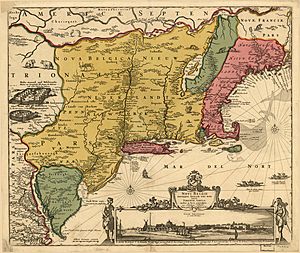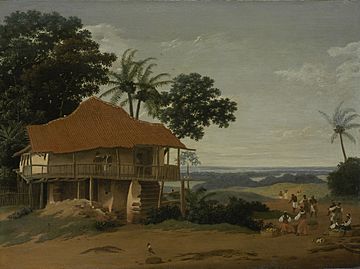Dutch colonization of the Americas facts for kids
The Netherlands started exploring and settling in the Americas, setting up trading posts and farms. This happened even before their more famous activities in Asia. For example, the first Dutch forts in Asia were built in 1600, but in South America, along the Essequibo River in Guyana, forts and settlements were there by the 1590s!
Unlike some other European countries, the Dutch didn't always send huge numbers of people to live in these new lands. Many Dutch settlements were lost or left empty by the end of the 1600s. However, the Netherlands kept control of Suriname until it became independent in 1975. Today, only the Dutch Caribbean islands are still part of the Kingdom of the Netherlands.
Contents
Dutch in North America
In 1602, the Dutch Republic created the Dutch East India Company (VOC). Its main goal was to find a direct sea route to Asia by exploring North American rivers and bays. Along the way, Dutch explorers were told to claim any new lands for the Netherlands. This led to important trips and the founding of a new area called New Netherland.
By 1610, the VOC had hired an English explorer named Henry Hudson. While trying to find a shortcut to Asia, he discovered and claimed parts of what are now the United States and Canada for the Dutch. Hudson sailed into the Upper New York Bay and went up the river that is now named after him.
In 1614, Adriaen Block explored the lower Hudson River and the East River. He was the first European known to sail through the tricky waters of the Hell Gate to reach Long Island Sound. Block Island and Block Island Sound are named after him. When he returned to Amsterdam, Block made a map and named the area between English Virginia and French Canada 'New Netherland'. He was given special trading rights there.
The first Dutch settlement in the Americas was Fort Nassau, built in 1615 on Castle Island near what is now Albany. It was mainly a trading post for furs with the native Lenape people. Later, it was replaced by Fort Orange. Both forts were named after the Dutch royal family, the House of Orange-Nassau.
In 1621, the Dutch created a new company, the Dutch West India Company (WIC). This company had a trading monopoly in the Americas and West Africa. The WIC wanted to be known as founders of the New World, and they officially founded the province of New Netherland in 1623. That year, another Fort Nassau was built on the Delaware River in what is now Gloucester City, New Jersey.
In 1624, the first colonists, many of them Walloons (people from a region in Belgium) and their servants, arrived in New Netherland. They landed at Governors Island. In 1626, the WIC Director, Peter Minuit, bought the island of Manhattan from the Lenape natives. He started building Fort Amsterdam, which grew into the main port and capital, New Amsterdam. The colony expanded to nearby areas like Brooklyn, the Bronx, and Long Island.
On the Connecticut River, Fort Huys de Goede Hoop was finished in 1633 near present-day Hartford. However, by 1653, English settlers had taken over this Dutch trading post.
The Dutch also expanded along the Delaware River after taking over a Swedish colony in 1655. The settlements at Fort Nassau were moved and combined at Fort Casimir.
Not everyone in New Netherland was Dutch. Many people came from other European countries like Walloons, Huguenots (French Protestants), Germans, Scandinavians, and English settlers from New England. A large number of African people were also brought there as slaves.
In 1664, an English navy expedition, sent by Prince James, the Duke of York, arrived in the harbor of New Amsterdam. The English threatened to attack. Since the Dutch were greatly outnumbered, their leader, Peter Stuyvesant, surrendered. The province was then renamed New York after Prince James. Fort Orange was renamed Fort Albany. The land between the Hudson and Delaware rivers became New Jersey.
Losing New Netherland led to the Second Anglo–Dutch War (1665–1667). This war ended with the Treaty of Breda, where the Dutch gave up their claim to New Netherland in exchange for Suriname.
From 1673 to 1674, the Dutch briefly recaptured these territories during the Third Anglo–Dutch War. But they were returned to England in the Treaty of Westminster.
Dutch in the Caribbean Sea
Dutch Caribbean Islands
Dutch colonization in the Caribbean began in 1634 on Curaçao and Bonaire, and in 1636 on Sint Eustatius. They had also tried to settle on St. Croix and Tobago earlier. When the Dutch lost Sint Maarten to the Spanish, they focused on Curaçao and Sint Eustatius. They got half of Sint Maarten back in 1648, sharing the island with France ever since.
Other islands settled by the Dutch include:
- Sint Maarten in 1618
- Aruba in 1637
- Saba in 1640
- Tortola, Virgin Gorda, and Jost van Dyke before 1640
Until the late 1800s, some islands now belonging to Venezuela, like Aves and Los Roques, were also considered Dutch.
The Netherlands Antilles (a group of these islands) remained a Dutch territory. They gained self-rule in 1954. In 1986, Aruba became a separate country within the Kingdom of the Netherlands. On October 10, 2010, the Netherlands Antilles was broken up. Curaçao and Sint Maarten also became separate countries within the Kingdom, while Bonaire, Saba, and Sint Eustatius became special municipalities of the Netherlands.
Tobago
The Netherlands tried many times to colonize Tobago in the 1600s. Each time, their settlements were destroyed by other European powers.
Virgin Islands
The Dutch set up a base on St. Croix in 1625, the same year the British did. French Protestants joined the Dutch, but fighting with the British led to the Dutch leaving before 1650. The Dutch also settled on Tortola before 1640, and later on Anegada, Saint Thomas, and Virgin Gorda. The British took Tortola in 1672 and Anegada and Virgin Gorda in 1680.
Dutch in South America
Brazil
From 1630, the Dutch Republic took control of a large part of northeastern Brazil from the Portuguese. The Dutch West India Company set up its main office in Recife. The Dutch also brought a tradition of religious tolerance to their new colony. The governor, Johan Maurits, invited artists and scientists to help encourage people to move to the new South American colony.
However, the Portuguese fought back. They won an important battle in 1649. On January 26, 1654, the Dutch surrendered and gave control of the northeastern Brazil colony back to the Portuguese. After a war with England ended in 1654, the Dutch demanded that their Brazilian colony, called Nieuw Holland, be returned. The Portuguese, who were already fighting Spain, agreed. But the new Dutch political leader, Johan de Witt, thought trade was more important than land. So, New Holland was sold back to Portugal on August 6, 1661, through the Treaty of The Hague.
Chile
In 1600, the Chilean city of Valdivia was briefly taken by the Dutch pirate Sebastian de Cordes. He left after a few months. In 1642, the Dutch sent a fleet to Chile to conquer Valdivia and its supposed gold mines. This trip was led by Hendrik Brouwer, a Dutch admiral. In 1643, Brouwer died, but his assistant, Elias Herckmans, captured the ruins of the city. He rebuilt it and named it Brouwershaven. But they found no gold and many angry native people, so the Dutch soon left the outpost.
Later, in the late 1800s and early 1900s, some Dutch families moved to Chile, especially to areas like Chiloé and near Puerto Montt. Another group of Dutch people, called Boers, came from South Africa to Chile in the early 1900s after the Boer War. Today, it's estimated that about 50,000 people in Chile are descendants of these Dutch immigrants.
Guianas
The Dutch West India Company built a fort in 1616 on the Essequibo River. The Dutch traded with the native people and, like in Suriname, set up sugar plantations where African slaves were forced to work. While the coast stayed under Dutch control, the English also started plantations west of the Suriname River. The region changed hands several times between the Dutch and English due to conflicts. By 1796, Britain controlled the area. The Netherlands officially gave the colonies of Essequibo, Demerara, and Berbice to Britain in 1814.
The colony in Suriname was first started by the British in the 1650s. But it was captured by the Dutch during the Second Anglo–Dutch War. In 1667, under the Treaty of Breda, the Dutch offered New Netherland (which included New Amsterdam, now New York City) in exchange for their sugar factories on the coast of Suriname. In 1683, Suriname was sold to the Dutch West India Company. The colony's economy relied on farming done by African slaves.
England controlled Suriname during the Napoleonic Wars from 1799 until 1816, when it was returned to the Dutch. The Netherlands ended slavery in 1863. After that, they brought in workers from British India and the Dutch East Indies to keep the economy going. Suriname gained self-governance in 1954 and full independence in 1975. Many people from Suriname moved to the Netherlands after independence. Today, the Surinamese community in the Netherlands is very large.
See also
 In Spanish: Colonización neerlandesa de América para niños
In Spanish: Colonización neerlandesa de América para niños





